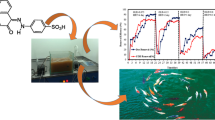Abstract
Application of chlorpyrifos (CP) has increased its environmental concentration. Increasing CP concentration has increased chances of adverse health effects. Its removal from environment has attained researcher’s attention. CP degrading bacterial strains were isolated from wastewater and agricultural soil. Finally, selected five bacterial strains were identified using 16S rRNA nucleotide sequence analysis as Pseudomonas kilonensis SRK1, Serratia marcescens SRK2, Bacillus pumilus SRK4, Achromobacter xylosoxidans SRK5, and Klebsiella sp. T13. Interaction studies among bacterial strains demonstrated possibility for development of five membered bacterial consortium. Biodegradation potential of bacterial consortium was investigated in the presence of petrochemicals and trace metals. About 98 % CP removal was observed in sequencing batch reactors at inoculum level, 10 %; pH, 7; CP concentration, 400 mgL−1, and HRT, 48 h. Experimental data has shown an excellent fit to first order growth model. Among all petrochemicals only toluene (in low concentration) has stimulatory effect on biodegradation of CP. Addition of petrochemicals (benzene, toluene, and xylene) in high concentration (100 mg L−1) inhibited bacterial activity and decreased CP removal. At low concentration i.e., 1 mg L−1 of inorganic contaminants (Cu, Hg, and Zn) >96 % degradation was observed. Addition of Cu(II) in low concentration has stimulated CP removal efficiency. Hg(II) in all concentrations has strongly inhibited biodegradation rate except at 1 mgL−1. In simulated pesticide, wastewater CP removal efficiency decreased to 77.5 %. Outcomes of study showed that both type and concentration of petrochemicals and trace metals influenced biodegradation of CP.






Similar content being viewed by others
References
Abraham J, Silambarasan S (2013) Biodegradation of chlorpyrifos and its hydrolyzing metabolite 3,5,6-trichloro-2-pyridinol by Sphingobacterium sp. JAS3. Process Biochem 48:1559–1564
Anwar S, Liaquat F, Khan QM, Khalid ZM, Iqbal S (2009) Biodegradation of chlorpyrifos and its hydrolysis product 3, 5, 6-trichloro-2-pyridinol by Bacillus pumilus strain C2A1. J Hazard Mater 168:400–405
Briceno G, Fuentes MS, Palma G, Jorquera MA, Amoroso MJ, Diez MC (2012) Chlorpyrifos biodegradation and 3, 5, 6- trichloro-2-pyridinol production by Actinobacteria isolated from soil. Int Biodeterior Biodegrad 73:1–7
Chu XY, Wu NF, Deng MJ, Tian J, Yao B, Fan YL (2006) Expression of organophosphorus hydrolase OPHC2 in Pichia pastoris: purification and characterization. Protein Expr Purif 49:9–14
Cycon M, Zmijowska A, Wójcik M, Piotrowska-Seget Z (2013) Biodegradation and bioremediation potential of diazinon-degrading Serratia Marcescens to remove other organophosphorus pesticides from soils. J Environ Manag 117:7–16
Denga S, Chena Y, Wang D, Shi T, Wu X, Ma X, Li X, Huaa R, Tang X, Li QX (2015) Rapid biodegradation of organophosphorus pesticides by Stenotrophomonas sp. G J Hazard Mater 297:17–24
Helbling DE (2015) Bioremediation of pesticide-contaminated water resources: the challenge of low concentrations. Curr Opin Biotechnol 33:142–148
Jiang C, Xu X, Megharaj M, Naidu R, Chen Z (2015) Inhibition or promotion of biodegradation of nitrate by Paracoccus sp. in the presence of nanoscale zero-valent iron. Sci total Environ 530–531:241–246
Kauffmann C, Mandelbaum RT (1998) Entrapment of atrazine chlorohydrolase in solegel glass matrix. J Biotechnol 62:169–176
Khalid S, Hashmi I (2016) Biotreatment of chlorpyrifos in a bench scale bioreactor using Psychrobacter alimentarius T14. Environ Technol 37:316–325
Kim J, Chao KJ, Han G, Lee C, Hwang (2013) Effect of temperature and pH on the biokinetic properties of thiocyanate biodegradation under autotrophic conditions. Water Res 47:251–258
Kolpin DW, Thurman EM, Linhart SM (2000a) Finding minimal herbicide concentrations in ground water? Try looking for their degradates. Sci Total Environ 248:115–122
Kolpin DW, Barbash JE, Gilliom RJ (2000b) Pesticides in ground water of the United States, 1992–1996. Ground Water 38:858–863
Lakshmi CV, Kumar M, Khanna S (2008) Biotransformation of chlorpyrifos and bioremediation of contaminated soil. Int Biodeterior Biodegrad 62:204–209
Li X, He J, Li S (2007) Isolation of a chlorpyrifos-degrading bacterium, Sphingomonas sp. strain Dsp-2, and cloning of the mpd gene. Res Microbiol 1581:143–149
Mahmood S, Khalid A, Arshad M, Ahmad R (2015) Effect of trace metals and electron shuttle on simultaneous reduction of reactive black-5 azo dye and hexavalent chromium in liquid medium by Pseudomonas sp. Chemosphere 138:895–900
Maya K, Singh RS, Upadhyay SN, Dubey SK (2011) Kinetic analysis reveals bacterial efficacy for biodegradation of chlorpyrifos and its hydrolyzing metabolite TCP. Process Biochem 46:2130–2136
Mishra A, Malik A (2014) Novel fungal consortium for bioremediation of metals and dyes from mixed waste stream. Bioresour Technol 171:217–226
Olson GJ, Brierley JA, Brierley CL (2003) Bioleaching review part B. Appl Microbiol Biotechnol 63:249–257
Pointing SB, Bucher VVC, Vrijmoed LLP (2000) Dye decolorization by subtropical basidiomycetous fungi and the effect of metals on decolorizing ability. World J Microbiol Biotechnol 16:199–205
Reddy GVS, Reddy BR, Tlou MG (2014) Biodegradation of 2-hydroxyquinoxaline (2-HQ) by bacillus sp. J Hazard Mater 278:100–107
Rauh V, Arunajadai S, Horton M, Perera F, Hoepner L, Barr DB, Whyatt R (2011) 7-year neurodevelopmental scores and prenatal exposure to chlorpyrifos, a common agricultural pesticide. Environ Health Perspect 119:1196–1201
Saez JM, Alvarez A, Benimeli CS, Amoroso MJ (2014) Enhanced Lindane removal from soil slurry by immobilized Streptomyces consortium. Int Biodeterior Biodegrad 93:63–69
Sarkouhi M, Shamsipur M, Hassan J (2012) Metal ion promoted degradation mechanism of chlorpyrifos and phoxim. Arab J Chem. doi:10.1016/j.arabjc.2012.04.026
Singh BK, Walker A, Wright DJ (2004) Biodegradation of chlorpyrifos by Enterobacter strain B-14 and its use in bioremediation of contaminated soils. Appl Environ Microbiol 70:4855–4863
Singh BK, Walker A, Wright DJ (2006) Bioremedial potential of fenamiphos and chlorpyrifos degrading isolates: influence of different environmental conditions. Soil Biol Biochem 38:2682–2693
Shomar BH (2006) Trace elements in major solid-pesticides used in the Gaza strip. Chemosphere 65:898–905
Swissa N, Nitzan Y, Langzam Y, Cahan R (2014) Atrazine biodegradation by a monoculture of Raoultella planticola isolated from a herbicides wastewater treatment facility. Int Biodeterior Biodegrad 92:6–11
Tastan BE, Donmez G (2015) Biodegradation of pesticide triclosan by A. Versicolor in simulated wastewater and semi-synthetic media. Pestic Biochem Physiol 118:33–37
Vijayalakshmidevi SR, Muthukuma K (2015) Improved biodegradation of textile dye effluent by coculture. Ecotoxicol Environ Saf 14:23–30
Yadav M, Srivastva N, Singh SR, Upadhyay SN, Dubey SK (2014) Biodegradation of chlorpyrifos by Pseudomonas sp. in a continuous packed bed bioreactor. Bioresour Technol 165:265–269
Yang SF, Wang CC, Chems CH (2014) Di-n-butyl phthalate removal by strain Deinococcus sp. R5 in batch reactors. Int Biodeterior Biodegrad 95:55–60
Zhang X, Shen Y, Yu X, Liu X-J (2012) Dissipation of chlorpyrifos and residue analysis in rice, soil and water under paddy field conditions. Ecotoxicol Environ Saf 78:276–280
Author information
Authors and Affiliations
Corresponding author
Additional information
Responsible Editor: Gerald Thouand
Electronic supplementary material
ESM 1
(DOCX 14 kb)
Rights and permissions
About this article
Cite this article
Khalid, S., Hashmi, I., Jamal Khan, S. et al. Effect of metal ions and petrochemicals on bioremediation of chlorpyrifos in aerobic sequencing batch bioreactor (ASBR). Environ Sci Pollut Res 23, 20646–20660 (2016). https://doi.org/10.1007/s11356-016-7153-8
Received:
Accepted:
Published:
Issue Date:
DOI: https://doi.org/10.1007/s11356-016-7153-8




